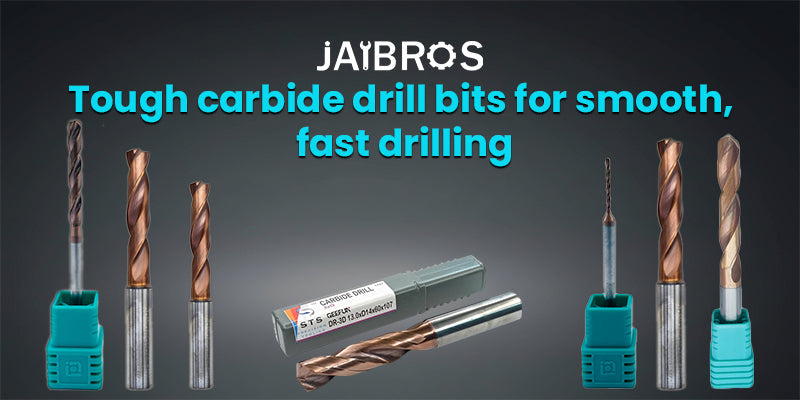Why Carbide Drills Are Essential for High-Performance Machining
In today's high-speed environment of manufacturing, precision, efficiency, and reliability are essential for any manufacturing operation to succeed. Whether you are dealing with metalworking, CNC machining, or tool fabrication, the right tools can make all the difference. One of the tools that has revolutionized the industrial drilling process is the carbide drill. Carbide drill bits are known for their strength and durability and are incredibly high-performance tools in the most challenging machining environments.
If you are seeking accuracy to increase productivity and tool life, the first step to higher productivity is understanding the carbide drill bit.
What are Carbide Drills?
Carbide drills are cutting tools manufactured principally with tungsten carbide, a material noted for its hardness, toughness, and wear resistance. Carbide also maintains cutting properties, stability, and sharpness at higher rates and temperatures while in a cutting state. Steel (HSS) drills lose properties at higher rates and temperatures during cutting, but carbide holds up much better while drilling different types of materials.
Carbides are used in aerospace, automotive, die-making, and other industrial processes where tolerances and repeatability are critical. Carbides are specifically designed for drilling hardened steels, cast iron, and non-ferrous metals, with pure cutting performance from break-in to tool failure rate, taking less time to do a better-cutting job than the steel or HSS drill while also providing a much longer tool life.
Why Choose to Invest in High-Performance Carbide Drills?
Investing in carbide is investing in efficiency. Drills are produced to handle higher cutting speeds, less vibration, and rounder holes. The following are reasons why professionals choose to work with carbide:
-
Hardness: Carbide material wears better than high-speed steel. And more heat resistant than HSS
-
Tool Life: Carbide drill bits will last several times longer than other drills (with proper usage).
-
Precision: Their rigidity reduces deflection; doing so allows for perfect alignment of holes. And repeatability is better than HSS
-
Heat Treatable: They will retain the cutting edge at high temperatures.
-
Flexible Versatility: Carbide tools will adapt to setups, including small-diameter drills, deep drilling, etc.
Each of the above characteristics allows carbide to become the most desirable tool for manufacturers in their goal of achieving maximum output while maintaining quality.
The Function of End Mills in Machining Productivity
Carbide drills perform vertical drilling, but end mills are required for contouring and side milling. One of the most common end mills found in CNC machining is the 1 mm to 20 mm carbide end mill, which is often utilized for finishing, shaping, and slotting applications. Since it is carbide, it can withstand high rotary speeds and high permissible contact with minimal tool wear.
Likewise, a 10 mm carbide end mill is suited for cutting applications requiring medium depth and will often promote greater accuracy and part stability. Both drills and end mills play a vital role in machining applications, provide smoother production, and provide better quality of the finished part.
Using premium carbide-grade tools like the 8mm and 20mm carbide end mills and the 10mm carbide end mill ensures your workshop is minimizing cycle and tool change times, which provides an extremely efficient machining experience while reducing costs.
Recognizing the Diameter of Milling Cutters and the Selection of Tools
Along with drill bits, milling cutter diameter also greatly impacts the end results of machining operations. If we take a milling cutter diameter of 20 mm, for example, it represents a large range of capacity for material removal and is ideal for cutting applications involving a heavy volume of material removal.
Selecting the appropriate milling cutter diameter is affected by many factors, including the size of the part, the hardness of the material, and the capacity of the machine. Larger diameter cutters, for example, a milling cutter with a diameter of 20 mm, are ideally suited for roughing applications, while smaller diameter and end mill cutters are suited for final finish applications. The correct cutter selected will produce optimum surface finish and best dimensional accuracy when used with carbide compatible with the milling cutter.
Solid Carbide Drill: The Paradigm for Quality
The final, yet nearly all-encompassing, category of drill technology that has elevated machining today is the solid carbide drill. Unlike the tipped carbide or brazed drills containing only a carbide edge, the solid carbide drill is made of a solid carbide body. This composition provides additional rigidity, precision, and wear resistance, resulting in solid carbide being capable of extreme high-speed drilling of hard materials.
Solid carbide drills provide minimal tool deflection or chip evacuation, produce cleaner holes, and can typically outlast existing tooling standards. In industries where consistency of performance is critical, solid carbide easily achieves the definition of perfection.
Carbide Drill Usage Tips
For an effective experience with drills, a few best practices can assist in creating a more productive process and longer tool life:
-
Utilize the proper feed and speed—carbide tools will perform best under optimized parameters.
-
Use a proper coolant—reduces the heat buildup and prolongs cutting edge life.
-
Ensure proper alignment—prevents uneven wear of the tool and promotes higher accuracy.
-
Keep an eye on chip evacuation—proper chip removal will hinder the tool breakage.
-
Use reputable tooling suppliers—the cost of certification is worth the price because tool reliability will assist your performance over time.
Once these factors are evaluated and accounted for, your machining process will become faster, cleaner, and more productive.
Why Carbide Drills Are Worth the Investment
While carbide tools tend to have a higher initial cost than regular high-speed steel bits, there’s no denying the overall value in the long run. Less downtime, lower replacement costs, and more efficient machining are some of the benefits of carbide. For any shop looking to be profitable and precise, drills will change the game.
From drilling holes in stainless steel to drilling composite materials, carbide will reliably deliver superb accuracy and finish under the most demanding conditions. Along with reliable end mills and cutters, carbide accelerates the production rate in a much more efficient and consistent manner.
About Jaibros
If you’re looking for high-quality industrial tools and precision machining accessories, look no further than Jaibros. We offer a comprehensive selection of carbide end mills and measuring instruments, all designed for high-efficiency and high-accuracy operations. Jaibros has successfully served skilled professionals in the manufacturing sector with durable, high-accuracy products focused on performance and customer satisfaction.
Frequently Asked Questions
Q1. Why are carbide drills superior to regular drills?
Carbide is harder, more resistant to heat, and lasts longer than regular drills, and is designed for high-speed and precision machining.
Q2. Can I drill stainless steel and hard alloys with carbide drills?
Yes, carbide can be used to drill difficult materials, including stainless steel, titanium, and cast iron, because of its hardness and toughness.
Q3. What is the difference between solid drills and tipped drills?
Solid carbide drill bits are made of 100% carbide and provide better stability and wear resistance than tipped drill bits, which are carbide only on the tip.
Q4. How does tool diameter impact milling performance?
Tools with larger diameters, such as 100 mm milling cutters, remove stock quickly than smaller diameters, resulting in more detailed, completed work.
Q5. How do I maintain carbide drills for consistent performance?
Use coolant and adhere to proper parameters, such as feed depth of cut and no vibration on components, to increase life. Proper storage in a plastic tube or box with single packing is also recommended.
Conclusion
In the fast-paced world of manufacturing, carbides are quickly becoming the premier option for industries that seek precision, durability, and productivity. Carbide drill bits can handle tough materials better than traditional drill bits while maintaining sharper edges and smoother finishes. Whether you’re using an 8 mm or 10 mm carbide end mill or need a solid, reliable carbide drill bit for high-speed applications, you will achieve efficiency and accuracy each time with the right tool.

